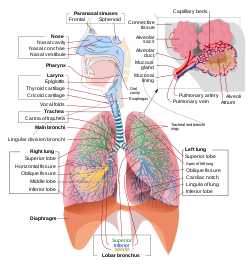Respiratory systems
| Respiratory system | |
|---|---|

A complete, schematic view of the human respiratory system with their parts and functions.
|
|
| Details | |
| Identifiers | |
| Latin | systema respiratorium |
| TA | A06.0.00.000 |
| FMA | 7158 |
|
Anatomical terminology
[]
|
|
The respiratory system (also respiratory apparatus, ventilatory system) is a biological system consisting of specific organs and structures used for the process of respiration (breathing) in an animal. The anatomy of the respiratory system is made up of the organs and structures of the respiratory tract. In humans, and other mammals, the respiratory tract includes the airways of the trachea, bronchi, and bronchioles; the lungs and alveoli, and the diaphragm and other muscles of respiration.
In vertebrates, excluding fish, the respiratory system is involved in the intake of oxygen from the air breathed in and the release of carbon dioxide from the blood which is breathed out. This process of gas exchange takes place in the alveoli of the lungs and is the main function of the respiratory system.
In fish and many invertebrates, respiration takes place through the gills. Other animals, such as insects, have respiratory systems with very simple anatomical features, and in amphibians even the skin plays a vital role in gas exchange. Plants also have respiratory systems but the directionality of gas exchange can be opposite to that in animals. The respiratory system in plants also includes anatomical features such as stomata, that are found in various parts of the plant.
...
Wikipedia
